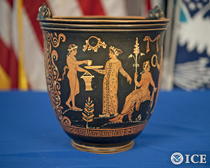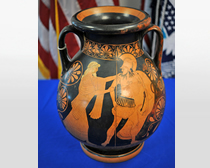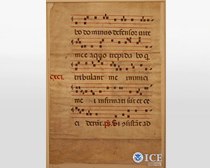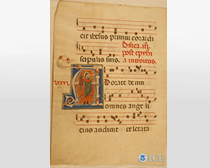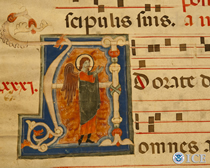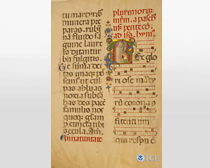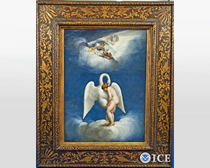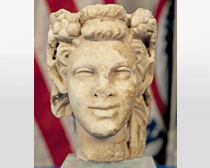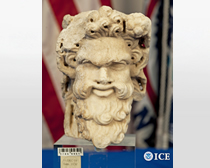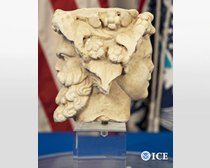Archived Content
In an effort to keep ICE.gov current, the archive contains content from a previous administration or is otherwise outdated. This information is archived and not reflective of current practice.
ICE returns stolen and looted art and antiquities to Italy
WASHINGTON — Seven stolen and looted objects of Italian cultural heritage will soon be on their way back to Italy, following a ceremony Thursday in which U.S. Department of Homeland Security (DHS) Secretary Janet Napolitano officially returned the antiquities to Italian Ambassador Claudio Bisogniero at the Embassy of Italy in Washington.
Two 2,000-year-old ceramic vessels, one Roman marble sculpture, one Renaissance painting and three music sheets from choir books dating back to the 13th century were recovered during four investigations by U.S. Immigration and Customs Enforcement's (ICE) Homeland Security Investigations (HSI). All four of the investigations involved the collaboration of ICE's offices in New York and Rome and Italy's national police force, the Carabinieri.
"The United States and the Department of Homeland Security are proud to honor our commitments to our ally, Italy," said Secretary Napolitano. "We will continue to work to ensure cultural artifacts and treasures that were stolen and entered this country illegally are recovered and returned to their rightful home nations."
"The return of several important stolen works of art to Italy marks a new step in the fruitful bilateral collaboration between Italy and the United States. It is an event that falls within the framework of a well consolidated partnership in which our two countries successfully work side by side against all forms of criminal activity," said Ambassador Bisogniero. "Given the quality of some of the antiquities that have been returned," continued the ambassador, "the ceremony held today at the embassy should also be viewed as a chapter of the vital cultural relationship between Rome and Washington."
ICE Director John Morton, Commander of Carabinieri for the Protection of Cultural Heritage General B. Pasquale Muggeo and Assistant U.S. Attorney Sharon Levin, Chief of the Asset Forfeiture Unit, U.S. Attorney's Office for the Southern District of New York, also participated in the repatriation ceremony.
"Conducting these investigations and heralding their results sends a strong message. ICE is serious about reining in art and antiquity thieves, smugglers, and traffickers," said Morton. "Together with the Carabinieri and agencies like Interpol, the Department of Justice, and our sister agency U.S. Customs and Border Protection, we intend to turn the tide on art and antiquity thieves."
"The operational success of the investigations made it possible not only to return important masterpieces to the Italian State which had been stolen from its national cultural heritage but, once again, highlights the fruitful and close co-operation which exists between the Protection of Cultural Heritage Carabinieri's Headquarters and U.S. authorities in their common endeavor to rebuild and hand down to posterity," said General Muggeo.
Manhattan U.S. Attorney Preet Bharara said, "In securing the forfeiture of these important objects of Italian cultural property and returning them to the Italian government, we are giving back to the Italian people a small piece of their history — and that could not be more gratifying. The work we do with our law enforcement partners in the United States and throughout the world to recover illegally imported property and return it to its rightful owners remains a high priority for this office."
Two of the four investigations have been linked to Gianfranco Becchina, an Italian national allegedly associated with Italian organized crime and a competitor of the Giacomo Medici smuggling organization, which has been identified by the Carabinieri as the most prolific known traffickers of Italian cultural heritage.
The first investigation tied to Becchina is the case involving the two 2,000-year-old ceramic vessels. In 2009, investigators learned about the sale of an Attic red-figured pelike, circa 480-460 B.C. for $80,500, and a red-figured situla, circa 365-350 B.C. for $40,000, at Christie's New York auction house. The investigation determined that these two objects were looted from archeological sites in Italy and smuggled into Switzerland. The ownership of the objects was transferred before they arrived in a Beverly Hills, Calif., gallery and subsequent consignment to Christie's in New York. HSI special agents in New York seized the objects, and upon authentication, both were forfeited for return.
The second investigation tied to Becchina involved a Roman marble statue, a janiform herm that was believed to have been smuggled out of Italy into the United States via Switzerland. HSI special agents in New York initiated an investigation into the sculpture which had been auctioned and sold at Christie's for $26,250. It was later seized at Christie's pursuant to a seizure warrant obtained by the U.S. Attorney's Office for the Southern District of New York and in May 2011, forfeited to HSI for return to Italy.
HSI's investigation concluded that the two ceramic vessels and the statue were removed from Italy in violation of Italian law and brought into the United States in violation of U.S. customs laws and regulations. Specifically, the objects had been removed in violation of a bilateral agreement negotiated by the U.S. State Department, first in 2001 and renewed in 2006 and 2011, between the United States and Italy prohibiting the importation of certain Italian archaeological material into the United States without proper export documents.
A third investigation began in 2008, when HSI special agents in New York received information concerning a renaissance painting, "Leda e il Cigno" (Leda and the Swan) by Lelio Orsi. The investigation revealed that the painting had been illegally imported into the United States in 2006 through New York's JFK International Airport and auctioned at Sotheby's New York in January 2008 for $1.6 million. The buyer rescinded the purchase after learning of the Italian criminal investigation and it was judicially forfeited in January 2011 to HSI by the U.S. Attorney's Office for the Southern District of New York.
The fourth investigation began in 2010, in Portland, Ore., concerning two illuminated choir book leaves. The pages are believed to have been removed from two different antique chorus books, one stolen from the St. Paul Church in Pistoia, Italy, in 1990, and the other from the Monastery of Monte Oliveto Maggiore, Siena, Italy, in 1975. The manuscript pages were being offered for sale online by a rare book dealer in Oregon. HSI special agents in Portland investigated the case and the manuscript leaves were surrendered by the dealer. In June 2011, the special agents seized a third manuscript page that had been the subject of a previous investigation but never recovered. The same book dealer had the choir book page in his possession, and, after examining evidence of the theft provided by the Italian government, agreed to surrender it to HSI special agents.
HSI plays a leading role in criminal investigations that involve the illicit importation and distribution of cultural property, as well as the illegal trafficking of artwork, specializing in recovering works that have been reported lost or stolen. The HSI Office of International Affairs, through its 71 attaché offices in 47 countries, works closely with foreign governments to conduct joint investigations, when possible.
HSI's specially trained investigators, assigned to both domestic and international offices, partner with governments, agencies and experts to protect cultural antiquities. They also train investigators from other nations and agencies to investigate crimes involving stolen property and art, and how to best enforce the law to recover these items when they emerge in the marketplace.
Those involved in the illicit trafficking of cultural property, art and antiquities can face prison terms of up to 20 years, fines and possible restitution to purchasers of the items.
Since 2007, HSI has repatriated more than 2,500 items to more than 23 countries.
Learn more about HSI cultural property, art and antiquities investigations.


